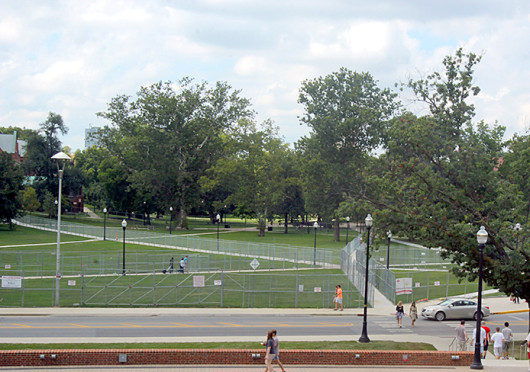
There are more than 400 geothermal wells drilled to a depth of 550 feet beneath the South Oval, completed August 2013.
Credit: Shelby Lum / Photo editor
Some of Ohio State’s recent green energy efforts are being recognized on a national level.
OSU was one of four U.S. organizations to receive the Green Power Partner of the Year award from the U.S. Environmental Protection Agency, which recognizes organizations that distinguish themselves through their purchase, leadership, overall strategy and impact on the green power market.
OSU purchased 50 megawatts of wind power generation capacity and is projected to receive 141 million kilowatt-hours of wind annually, worth 25 percent of the university’s overall electricity use, according to a press release.
Cisco Systems, Inc., Georgetown University and Microsoft Corporation also received the 2013 award.
Lindsay Komlanc, OSU spokeswoman for Administration and Planning, said the award recognizes the work OSU has been doing.
“We have really focused on looking at how we build our buildings, ensuring they are as energy-efficient as possible, but have also recognized that we need to move beyond to ensure the energy we do use is sustainable,” Komlanc said in an email.
Komlanc said the wind power initiative helps OSU take a big step toward becoming a “carbon neutral university,” a commitment the university has been working toward since it signed the American College and University Presidents’ Climate Commitment in 2008.
This commitment is an effort to address climate disruption by eliminating greenhouse gas emissions and to recognize schools’ research and educational efforts, according to the organization’s website.
“At Ohio State, we believe that our future competitiveness depends on being innovative leaders, developing the technologies and embracing the cultural changes necessary to thrive in a world that must reduce carbon emissions,” Komlanc said. “Most importantly, we believe the best place to start is at home, with our efforts to achieve carbon neutrality in our operations.”
OSU is working to become more sustainable with other projects as well.
In August 2012, through a partnership with the City of Columbus, OSU provided $2 million in funding for the removal of the Fifth Avenue Dam in the Olentangy River. The goal of the $6.9 million project, while still in development, is to return the river to a natural flow, improving water quality and the river’s ecosystem, Komlanc said.
In Spring 2013, OSU began installing energy conservation measures in five buildings on campus. Scott Lab, Biomedical Research Tower, the RPAC, Physics Research Building and Veterinary Medical Center’s Hospital for Companion Animals were chosen based on their large square footage and significant energy use, and the project intends to reduce the energy utilization index of the buildings by an average of 30 percent, Komlanc said.
“The project will leverage the energy savings gained through the implementation of ECM’s and use those savings to fund the cost of the project,” Komlanc said.
OSU then completed more than 400 geothermal wells on the South Oval in August 2013. The project cost $12 million, about $1.7 million more than originally budgeted, and was finished roughly a year after it was expected to because of a change in contractors due to ineffective methods the first construction company was using. The original $10.3 million budget was expected to pay for itself in about 10 years.
“The complete system includes more than 400 wells drilled to a depth of 550 feet, (that) are undetectable now that construction is complete,” Komlanc said. “The system will dramatically reduce the university’s energy consumption over the life of the buildings, and it is estimated that an average of 31 percent of the heating and cooling demands in the South District residence halls will be provided by these geothermal wells.”
Last year, Ohio Stadium became the largest stadium in the country to achieve “zero waste,” which requires recycling or composting at least 90 percent of gameday waste. This year, the estimated cost of the program was $38,000.
“We won first place in a national recycling competition among stadiums, recycling or composting 98.2 percent of all gameday waste in our home game against Illinois in 2012. For these efforts, we were named one of ten ‘collegiate game changers’ according to the Natural Resources Defense Council,” Komlanc said.
Libby Straub, a fourth-year in English, said OSU deserves to be awarded for its sustainability practices.
“OSU works very hard in terms of making the university more sustainable, especially by using wind energy and geothermal wells,” Straub said. “Recycling is also promoted all throughout campus, so I’m not surprised that OSU won this award.”
Chris Wrobel, a second-year in chemical engineering and a member of the Undergraduate Student Government sustainability committee, said the committee is working toward improving OSU’s green status as well.
“Many of our projects aim to encourage students to be more green,” Wrobel said. “Sustainability is something that should be promoted on all college campuses. If a school this big can do it, then any school can.”


